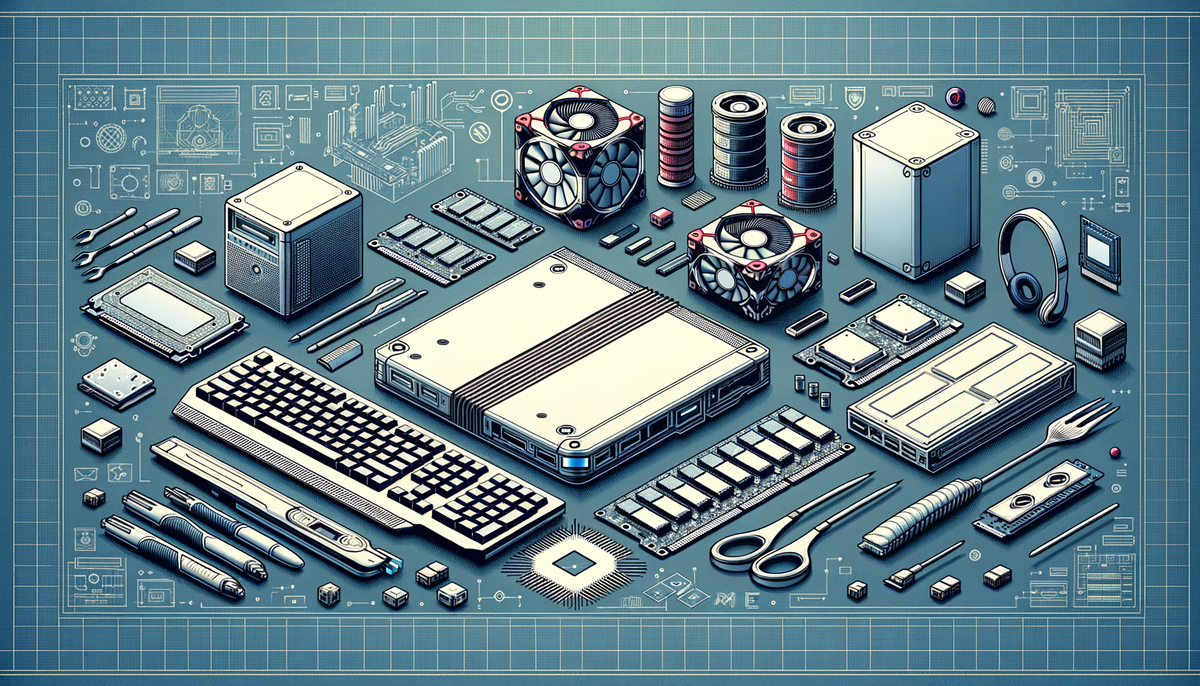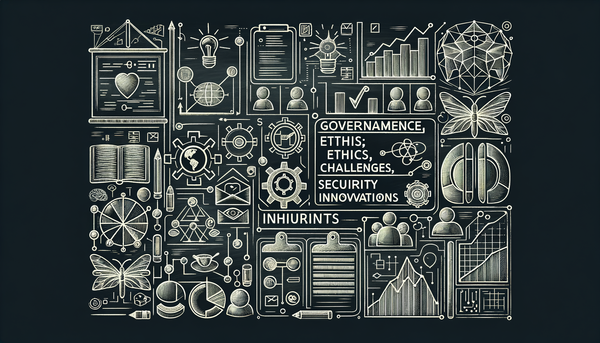Today's Highlights in AI: Innovations, Warnings, and Insights

Razer's new Blade 18 may seem like a space heater at a glance, yet its trial run reveals intriguing engineering compromises, while a leap in NAND technology by SK Hynix hints that storage innovation still has surprises up its sleeve; these stories, together with market fluctuations, evolving UI dynamics, and data security challenges, underscore that every technological breakthrough or setback carries lessons for AI enthusiasts and consumers alike.
Gaming Hardware and Next-Gen Components
The recent hands-on evaluation of Razer's Blade 18, powered by the flagship RTX 5090, has sparked a lively debate in tech circles over how far premium gaming laptops have come. While performance benchmarks are enticing, questions remain regarding thermals and noise management. Some users have observed that even high-end machines can sometimes lean closer to being “space heaters” than devices that maintain optimal operating conditions. It's a reminder that in the realm of high-performance computing, pushing hardware to the limit often means negotiating the fine line between raw power and thermal efficiency.
Parallel to these developments in gaming hardware, SK Hynix's announcement of batch-producing the industry's very first 300+ layer QLC NAND technology marks a significant milestone in memory evolution. Although this breakthrough may be slower to trickle down into affordable consumer SSDs—especially for capacities near 8TB—the early integration into PCs promises enhanced durability and performance. This advance not only hints at improved multi-layer storage performance but also underscores the nuanced challenges of cost management in semiconductor manufacturing.
These parallel narratives paint a broader picture of how balancing raw performance against practical, everyday usability remains a challenge across the board. For those curious about how such innovations might reshape the consumer tech landscape, you can check out additional insights on how transformation and challenges in AI and tech are unfolding on our latest update here.
AI Market Movements and Stock Trends
The financial world is abuzz with stock movements among tech players. Ambarella, a company highly positioned in the AI arena, saw its stock rise by 16% following earnings that were buoyed by an uptick in AI demand. Enthusiasm around applications such as advanced image processing algorithms and real-time video analytics is fueling investor confidence. This uptick is a testament to how AI-powered innovation is not just about transformative user experiences but also about driving measurable market value.
In stark contrast, chipmaker Marvell witnessed an 18% decline in its stock after quarterly results, primarily due to disappointing data center revenue results and tempered forward guidance. Such contrasting fortunes highlight the inherent volatility in the tech sector as market participants grapple with the implications of scalability, demand shifts, and the broader adoption limits of some of these emerging technologies.
While these market fluctuations might remind one of the adage "not every rally goes on forever," they also prompt further discussions about investor sentiment in areas such as AI software and semiconductor development. Recent analyses on our site, including discussions around leading-edge topics from our innovations challenges series, provide further context on these trends.
“AI is a reflection of the human mind—both its brilliance and its flaws.” – Sherry Turkle, Professor at MIT
This quote resonates strongly when considering both the triumphs and setbacks in the tech stocks influenced by AI trends. Whether it's the stellar performance of one company or the cautious outlook of another, every movement reminds us of the unpredictable nature of innovation.
Evolving User Interfaces in an AI Age
On a lighter yet equally intriguing note, the way we interact with our devices is also evolving. Gboard's latest update, where suggestions are now formatted as pills along with a simplified settings menu, reflects a broader trend towards intuitive and user-friendly interfaces. This seemingly minor tweak mirrors a design philosophy aiming to streamline user experience while still harnessing powerful AI-driven predictive text capabilities.
Furthermore, Meta has adjusted the responses of its teen-oriented chatbot amid growing scrutiny by Senate probes into the content of “romantic” conversations. This intervention highlights the delicate balance between offering engaging AI interactions and managing regulatory and societal expectations. It’s a dance where technological ambition meets the complexities of content moderation and ethical considerations.
Meanwhile, Anthropic’s new approach to using chats with its Claude AI for training purposes—and offering users the option to opt out—underscores the increasing importance of transparency and user control in AI systems. This initiative has spurred a lively debate among users and experts about privacy, trust, and the trade-offs between personalization and data security.
These updates resonate with a recurring theme: as AI systems become more deeply integrated into our daily lives, the channels through which we engage with technology must evolve in tandem. They pose questions on how much personalization is enough and where the lines must be drawn to safeguard user interests.
If you're interested in exploring how these user interface innovations are linked to broader shifts in AI research and development, consider diving into our detailed comprehensive overview of AI developments.
Security and Data Breach Concerns in AI Technologies
In the backdrop of innovation, concerns about security and data breaches remain prominent. Google’s recent warning regarding mass data theft impacting the Salesloft AI agent has added another layer to this growing narrative. As digital assistants and AI agents become more prevalent in business operations, the potential for significant vulnerabilities increases. The scale of these breaches can be alarming, as even sophisticated systems sometimes fall prey to persistent cyber attacks.
Adding to these challenges, discussions around the inherent difficulty of stopping malware—described as mathematically impossible by some security experts—further complicate the picture. The inherent complexity of cybersecurity means that threats evolve as quickly as countermeasures can be developed, which creates a perpetual cycle of attack and defense. This echoes the sentiment shared by many experts: as we build smarter systems, the underwater world of digital threats continues to shift and surprise us.
It is in these realms of cybersecurity and data protection that project management and innovation must step up hand in hand. To safeguard AI-driven applications, companies must hone robust security frameworks grounded in both proactive strategies and reactive measures. In this context, we find that innovation without security can be a double-edged sword—leaving users to navigate a labyrinth of vulnerabilities.
“By far, the greatest danger of Artificial Intelligence is that people conclude too early that they understand it.” – Eliezer Yudkowsky, Artificial Intelligence as a Positive and Negative Factor in Global Risk
This thought-provoking perspective challenges us to remember that as technology advances, so too must our understanding of it. Every new breakthrough brings with it responsibilities that extend beyond the lab into real-world applications and potential risks.
Highlights from Leading AI Events
Amid the whirlwind of hardware updates, stock market tremors, and evolving interfaces, major conferences continue to illuminate the future of AI. The TechCrunch Disrupt event, for instance, showcased a series of sessions backed by prominent voices at JetBrains and Greenfield. These sessions not only highlighted cutting-edge advancements but also fostered an environment of collaborative discussion where ideas flowed freely.
Events like these serve as a melting pot where theoretical research meets real-world application. From deep dives into new algorithms designed to optimize machine learning processes to panels debating the ethical applications of AI in everyday life, such forums are indispensable. They encapsulate a moment where thought leaders, developers, and enthusiasts converge to redefine what technology can achieve.
The energy at these gatherings is infectious. I myself have always felt that experiencing these sessions provides insights that no article or paper can fully capture. Whether it is the potential of generative AI to transform creative fields or the subtle nuances in subject algorithms that are revamping industries, the discussions are both intellectually stimulating and practically informative.
For those eager to catch up on the broader narratives shaping our digital future, our ongoing series on legal battles, job impacts, and the innovations driving AI offers an array of perspectives that underscore the event season’s vibrancy.
Further Readings and Reflections
The AI space is evolving at breakneck speed, and each headline, from hardware performance critiques to sweeping legal and cybersecurity developments, invites us to think critically about where technology is headed. The craftsmanship behind Razer's Blade 18 and the microscopic layers of QLC NAND technology share more than just technical details—they reflect the relentless human pursuit of progress. Both are underpinned by the same spirit that drives innovation in AI technologies and data handling practices today.
The entangled narratives of market volatility and security challenges reinforce the idea that innovation is never a straight path. Instead, it is a winding road marked by trials, errors, breakthroughs, and occasional missteps. With each new iteration—whether it be a more efficient graphical processor or a refined user interface—the journey continues to inspire both excitement and caution.
For further explorations on these topics and more in-depth insights into the multifaceted world of artificial intelligence, consider checking additional updates on AI.Biz. Our series on emerging trends, available here and our dedicated sessions on industry transformations, detailed in our innovation challenges series, are testament to the dynamic nature of this field.
As we peer into the future, it’s clear that the conversation around AI will continue to be as vibrant and complex as ever, pushing boundaries while urging us to tread with a mindful respect for both speed and security. It’s a vivid reminder that every time we engage with new tech, from gaming laptops that perform or overheat to AI systems that learn from our very conversations, we’re part of an unfolding narrative of human ingenuity and its unforeseen challenges.
Closing Thoughts
While innovations in hardware, stocks, and AI user interfaces generate excitement, the persistent challenges in cybersecurity and data protection remind us to balance progress with prudence. In reflecting on these dynamic shifts, I'm struck by how much the evolution of AI mirrors our own aspirations and anxieties. Every development, be it a transformation in physical hardware or a tweak in digital experience, invites us to think deeply about technology's role in shaping our lives.
As we continue to experiment, learn, and push the boundaries, one cannot help but marvel at how the dance between breakthrough and caution remains at the heart of the tech revolution. Perhaps, in time, this intricate ballet will lead us not only to smarter machines but to wiser choices in harnessing their potential.




